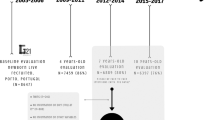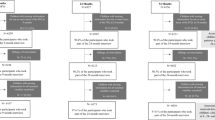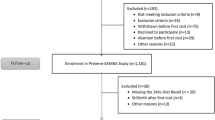Abstract
Study objective: The study of the whole diet in combination rather than the consumption of individual food items or the intake of specific nutrients could be enlightening. This has been previously performed using principal components analysis (PCA) on adult diets but not on those of children.
Design: The frequency of consumption of a range of food items was recorded for 10, 139 3-y-old children by their mothers using self-completion postal questionnaires. These children form part of the Avon Longitudinal Study of Pregnancy and Childhood (ALSPAC).
Methods: PCA was performed to identify individual dietary types which were then related to various socio-economic and demographic characteristics.
Results: Four distinct dietary components were obtained explaining 23.5% of the total variation in the sample, and the socio-demographic characteristics of the sample were related to them. The first represented a diet based on convenience foods and was associated with younger, less educated mothers and the presence of older siblings. The second was associated with a high consumption of foods currently considered to be healthy and was particularly related to vegetarian mothers and higher education levels. The third component described the established British ‘meat and two veg’ diet and was associated with girls and children with no older siblings, while the fourth had high loadings for snack and finger foods and was related to socially advantaged conditions and the presence of older siblings.
Conclusions: Identifiable groups of mothers were associated with feeding their child each of the four dietary types, supporting the hypothesis that social, demographic and lifestyle factors relating to the mother have an influence on the early eating patterns of children. This analysis will form a basis for the future study of various childhood outcomes including growth, health and development.
Sponsorship: University of Bristol
European Journal of Clinical Nutrition (2000) 54, 73–80
This is a preview of subscription content, access via your institution
Access options
Subscribe to this journal
Receive 12 print issues and online access
$259.00 per year
only $21.58 per issue
Buy this article
- Purchase on Springer Link
- Instant access to full article PDF
Prices may be subject to local taxes which are calculated during checkout
Similar content being viewed by others
Author information
Authors and Affiliations
Consortia
Contributions
Guarantor: Professor J Golding, director of ALSPAC.
Contributors: KN was responsible for the data analysis. KN and PE co-wrote the paper. The ALSPAC Study Team contribute to all aspects of running and maintaining a large longitudinal study.
Corresponding author
Rights and permissions
About this article
Cite this article
North, K., Emmett, P. & The Avon Longitudinal Study of Pregnancy and Childhood (ALSPAC) Study Team. Multivariate analysis of diet among three-year-old children and associations with socio-demographic characteristics. Eur J Clin Nutr 54, 73–80 (2000). https://doi.org/10.1038/sj.ejcn.1600896
Received:
Revised:
Accepted:
Published:
Issue Date:
DOI: https://doi.org/10.1038/sj.ejcn.1600896
Keywords
This article is cited by
-
The influential role of parents’ socioeconomic status and diet quality on their children’s dietary behavior: results from the LIPOKAP study among the Iranian population
BMC Pediatrics (2023)
-
Associations between mother–child dyad dietary patterns and child anthropometric measures among 6-year-old children
European Journal of Pediatrics (2022)
-
Ethnicity and socioeconomic status are related to dietary patterns at age 5 in the Amsterdam born children and their development (ABCD) cohort
BMC Public Health (2018)
-
Early factors related to carbohydrate and fat intake at 8 and 12 months: results from the EDEN mother–child cohort
European Journal of Clinical Nutrition (2017)
-
Dietary intake patterns of children aged 6 years and their association with socioeconomic and demographic characteristics, early feeding practices and body mass index
BMC Public Health (2016)



